September 2008
Featured Category
How did I get onto this topic? By Alice Bell
Photos courtesy of
CDHM Doll Artisans
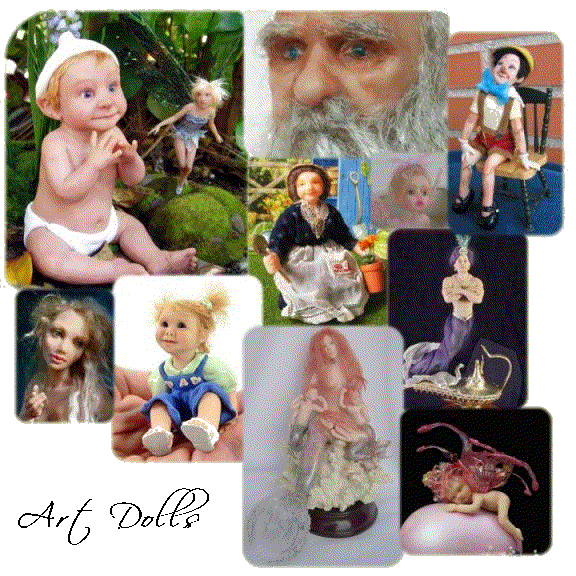
Throughout my childhood, dolls played a huge roll in my nightmares. They had big eyes – all the better to watch you with, my dears, anywhere you moved, Big Dolly was watching. Some of them even had real teeth – oh don't want to go there again!
And every year for Christmas, without fail – I Got Another One! 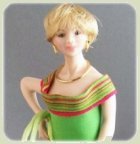
Little Kiddles were more my speed, along with their whacky buds, the Upsy Downsys. Tiny Dragon Wagons, little TVs with spinning screens and tiny rocking horses were enchanting, about the same size as my hands and went far toward heading me down my miniatures path.
Then, I discovered Chrissy, Velvet & Tressa, decidedly not dollhouse size but featuring long, growing hair I could play with for hours. That they came complete with a doll steamer trunk filled with beautiful clothes Santa (my mother) had stayed up late into the night sewing made playtime even better. I began, slowly, to feel a little more kindly disposed to the doll.
Then came Barbies™. Lots, and lots of Barbies™. And Dawn and friends. And Love, Peace and the Sunshine Family and all their collective tiny accessories.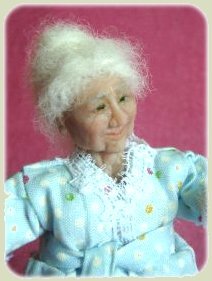
What does this disparate group all have in common? Each and every one of them now can be found on a collector's shelf. Each and every one was also a predecessor to the modern enchanting enigma that is called an Art Doll.
Defining that term is far harder than it looks. Doll? Art? Fabric? Poly clay? China? Encompassing the art doll is a dilemma.
The term itself appears to stem from France and the shops of the fashion couturier. The truly well-heeled left the houses of fashion they patronized with a wax or composition lady doll dressed in non-removable elegant clothing mimicking the style created by the establishment. Although these items were termed “toys” they were in reality far too fragile for the sandbox set and were more likely found proudly displayed on the dressing tables of the lady of the house or the eldest daughter. Soon, cheaper replicas began to fill the less vaunted shops patronized by the lower classes when they, too, wanted elegant dolls for their dresser tops.
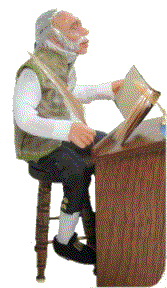
The trend was born. And what self-respecting artist anywhere, in any era, can be satisfied to simply repeat existing techniques? Certainly not Bernard Ravca, most likely the father of the expressive modern art doll. He believed each doll face needed to be as individual as a person's and used silk and chemically treated bread crumbs to create his dolls. And the future of the genre was secured. Gorgeous dolls of all expressions, sizes, materials and poses continue to spring from globally talented fingers.
The single unifying factor of all Art Dolls isn't in choice of materials, or shape, or size. Rather, it lies in the creation of a figure to represent some aspect of humanity or an emotion.
“It's a doll that tells a story, invokes a feeling, sets a mood. I like dolls with ATTITUDE!” said Marsha Mees of Sassy Mini Dolls. “I think it is when a sculptor has attained a certain quality that is beyond categorization, the doll connotes something outside itself. As with any piece of good art, the artist has said something more than what is directly sculpted out of clay,” said Janice Leotti of Faerie Moon Dream.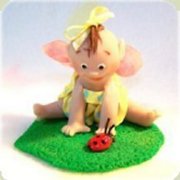
In my own collection, two particular Art Dolls reside in pride (yes, the Anti-Doll has happily discovered the Art Doll): Bat Girl, created by multi-talented artist Joyce Barlow Sterk of Mostly Art and a very guilty-looking baby in a Christmas stocking by Pam Poulakos (CDHM Hannypanny). Both figures are dollhouse scale, Bat Girl, an insouciant sexy vamp, lounges on my Halloweentown House roofline surveying all that transpires in the spooky realm while the baby has permanent residence above my work computer to provide me a giggle any time I look up. They both evoke an emotional response, not just from me, but from anyone who views them.
Other Art Dolls by other artists evoke similar emotional responses: a tender scene from Beauty and the Beast by Cheri Voellmann depicting Beauty holding the dying Beast because she broke her word and didn't return – it's my favorite scene in the fairy tale and Voellmann's creation is heartbreaking.
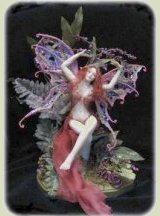 From fairy tale to fairies is an easy step. How about the amazing array of fairies in a vast range of poses with infinite accessories or creatures accompanying them that fill the viewer with a sense of wonder? Or how about the portrait dolls in the likeness of loved ones? Or the characters – riding motorcycles, wearing fluffy bunny slippers or holding half burned cigarettes – they're Art Doll: with attitude. Or how about the faceless figures who nevertheless through body positions and colors are so filled with attitude and sentiment they cannot be ignored?
From fairy tale to fairies is an easy step. How about the amazing array of fairies in a vast range of poses with infinite accessories or creatures accompanying them that fill the viewer with a sense of wonder? Or how about the portrait dolls in the likeness of loved ones? Or the characters – riding motorcycles, wearing fluffy bunny slippers or holding half burned cigarettes – they're Art Doll: with attitude. Or how about the faceless figures who nevertheless through body positions and colors are so filled with attitude and sentiment they cannot be ignored?
Any era in history, any form of reality, any legendary persona or any age can be represented in an Art Doll by a talented artist. “Currently I sculpt mostly Faerie dolls. I stumbled onto them on an auction site and couldn't believe people were actually sculpting these dolls! I had to try it,” said Leotti, whose faeries sparkle with life, captured as they are in the middle of living the full faery life. They come nestled inside equally delicately petaled flowers, riding flying fall leaves or iridescent bubbles and classically posed in intricate woodland settings.
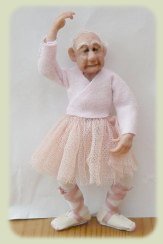
From the faery realm we cross back – partially! - into the human with Poulakos' caricature babies. “I could never quite find the dolls that I wanted myself! Even as a child I used to repaint my dollhouse families and make them tiny clothes. And I've always preferred the 1:12 scale to work in because I just love the whole dollhouse world,” said Poulakos. Her babies are mischievous and high spirited: twins are posed with one popping the other on the nose with an exuberantly flying hand, Christmas babies pop out of stockings looking guilty enough to have stolen ALL the sugarplums and one wayward tot is in the classic upside down pose peeking between her legs. One would think coming up with these expressions would be the hard part of creating the doll.
“The trickiest part for me is keeping the doll completely clean while working on it. Many times I have smashed a doll and started over because it got too many little smudges or pieces of fuzz while I was working,” she admitted. Finding the doll she wanted led Mees to recreate the wild, wild west.
“My first attempt at dolls was in the late 90's because I needed some characters for my Red Garter Saloon. It hasn't been until the last couple years that I found my niche with character dolls. I have to let the idea come to me, I can't force it. Sometimes I'll start off with an idea and somewhere in the process the doll takes on another personality, I let them speak to me, tell me what they want to be!” said Marsha.
Exactly like an Art Doll should.
- August 2008 - All About Turnings
Custom Dolls, Houses & Miniatures / CDHM



